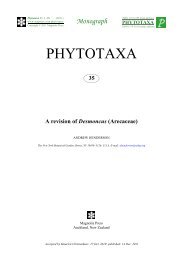Zootaxa, Taxonomy of Serpulidae (Annelida ... - Magnolia Press
Zootaxa, Taxonomy of Serpulidae (Annelida ... - Magnolia Press
Zootaxa, Taxonomy of Serpulidae (Annelida ... - Magnolia Press
You also want an ePaper? Increase the reach of your titles
YUMPU automatically turns print PDFs into web optimized ePapers that Google loves.
31. Pomatoleios Pixell, 1913<br />
(Fig. 36)<br />
Type-species: Pomatoleios crosslandi Pixell, 1913, junior synonym <strong>of</strong> Placostegus cariniferus var. kraussii Baird, 1865<br />
Number <strong>of</strong> species: 1<br />
Tube white or bluish, opaque, triangular in cross-section, with medial keel projecting into flap over the<br />
entrance. Granular overlay absent. Operculum inverse conical with flat calcareous plate; sometimes with talon<br />
projecting into opercular ampulla (best seen if operculum is cleared in glycerine). Peduncle thick, triangular in<br />
cross-section, with distal wings, without constriction, inserted almost medially, slightly left, covering base <strong>of</strong><br />
up to five radioles. Pseudoperculum absent. Radioles arranged in semi-circles, up to 19 per lobe, connected by<br />
very high inter-radiolar membrane. Branchial eyes present (single ocelli visible in fresh material only).<br />
Stylodes absent. Mouth palps present. 6 thoracic chaetigerous segments (in juveniles 7). Collar with entire<br />
edge, tonguelets between ventral and lateral collar lobes present; thoracic membranes forming ventral apron.<br />
Collar chaetae absent (limbate ones present in juveniles only). Apomatus chaetae absent. Uncini saw-shaped<br />
with fairly numerous (10–11) teeth, anterior peg wide and blunt, gouged (Fig. 36B). Triangular depression<br />
present. Abdominal chaetae true trumpet-shaped, abruptly bent, distally with two rows <strong>of</strong> denticles separated<br />
by a groove (Fig. 36A). Achaetous anterior abdominal zone absent. Posterior capillary chaetae and posterior<br />
glandular pad absent.<br />
FIGURE 36. SEM micrographs <strong>of</strong> chaetae in Pomatoleios kraussii. Madagascar, Tuléar, littoral, det. and don. H.<br />
Zibrowius, legit J. Picard, ZMA V.Pol. 3068. A—anterior abdominal chaetae with hollow tips, B—thoracic uncini <strong>of</strong> 1 st<br />
row.<br />
Remarks. Opercular talons as reported by Pillai (1965 fig. 22H) and ten Hove (1973 fig. 43) are not<br />
consistenly mentioned (nor looked for) in the literature. Whether or not the presence <strong>of</strong> such a talon is a<br />
character distinguishing between populations or even taxa should be investigated.<br />
Pomatoleios kraussii is widely distributed in the Indo-Pacific forming intertidal aggregations. The only<br />
difference between Pomatoceros and Pomatoleios is the more or less consistent lack <strong>of</strong> collar chaetae in the<br />
latter. However, collar chaetae may be present in juvenile specimens (Zibrowius 1968a, Crisp 1977, ten Hove<br />
& Nishi 1996), and occasionally absent in Pomatoceros (e.g., 9 specimens from the Irish Sea, ZMA V.Pol.<br />
3201) as well as in Spirobranchus (e.g., as Olga elegantissima Jones, 1962), thus this monotypic genus likely<br />
TAXONOMY OF SERPULIDS: STATE OF AFFAIRS<br />
<strong>Zootaxa</strong> 2036 © 2009 <strong>Magnolia</strong> <strong>Press</strong> · 77
















